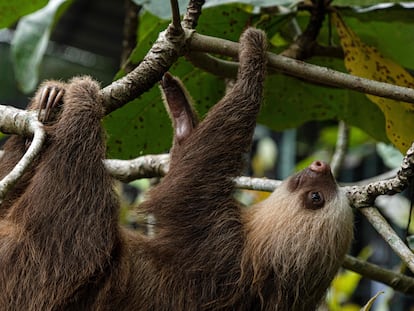Saving Borneo’s orangutans from the air
Scientists are using drones to locate the most isolated populations to protect them from the destruction of their habitat by logging, construction and monoculture plantations
The hum of blades rotating at high speed breaks the usual symphony of animal sounds in the Sabah rainforest on the Malaysian side of the island of Borneo. It is dawn in the jungle and the dense haze, heat and humidity are suffocating. Sweat beads the forehead of Sol Milne, a researcher and drone pilot who, with a slight push, gets the device to rise quickly above the lush forest canopy. The noise disturbs the tranquility of the jungle’s inhabitants, among them orangutans, the “men of the forest.” Jealously guarding their privacy, they camouflage themselves in the thick foliage. But researchers from HUTAN, a local conservation organization, have not come to capture images of these large primates in situ, but rather to follow in their footsteps.
They comb the terrain from the air, sometimes using thermal cameras, to find evidence of the presence of orangutans in the fragmented forest, which has been carved up by deforestation and human activity. Their goal is to locate the nests that, like craftsmen, the animals build to spend the night, abandoning them again at dawn to go in search of food. “We are using drones to take hundreds of photographs of the treetops in search of nests. We then analyze them with the help of computer programs. This way we can determine the density and distribution of the populations so that we can better protect them,” says biologist Serge Wich, a researcher at Liverpool John Moores University.
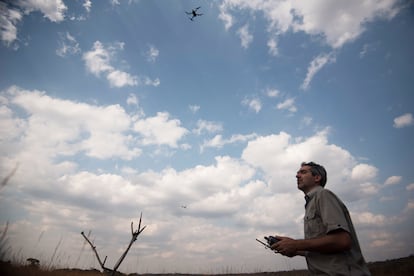
The main problem for conservationists is that 80% of the remaining orangutans, listed as critically endangered by the International Union for Conservation of Nature (IUCN) red list, are found outside protected areas, in scattered patches of jungle. They survive in small islands of green among oceans of plantations, human settlements, and tangles of roads. Researchers have recently discovered that orangutans have a greater presence in fragmented forests than previously thought. Females are very territorial and tend to stay with their young in the same place. It is the males who travel dozens of miles to pass on their genes. “But if we rescue them and relocate them in national parks, or if we eliminate the few natural corridors that still connect distant populations, the orangutans are irremediably doomed to disappear,” Wich says.
Drones have become the great ally of NGOs and foundations fighting for the survival of these animals. Previously, locating and monitoring was carried out on foot, walking in a straight line, through dipterocarp forests — the tallest tropical trees in the world, which can reach up to 100 meters in height — and through swampy and hostile terrain. No matter how isolated a nest may be, if it is photographed, it provides the documentary evidence needed to request that authorities protect these previously unknown populations. These great apes, with their characteristic reddish-orange fur, only exists in the wild in Indonesia and Malaysia. According to the latest estimates, there are about 14,000 Sumatran orangutans (Pongo abelii) remaining in Indonesia and around 100,000 individuals belonging to another species, the Bornean orangutan (Pongo pygmaeus), spread between Indonesia and Malaysia.
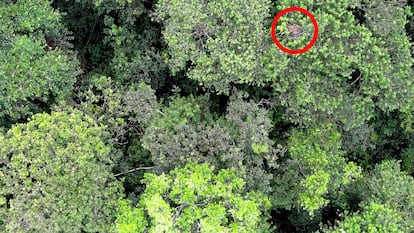
The “forest dwellers” are in serious danger of extinction due to the systematic destruction of their natural habitat. Conservation organizations estimate that between 1999 and 2015, around 100,000 orangutans disappeared. According to several studies, since 2000, Southeast Asia has lost 14% of its forests. “In the last 30 years, 80% of the orangutans’ natural space has been eliminated. Every year, the equivalent of 300 football fields disappear and some 6,000 orangutans die, if we are being optimistic,” says Leif Cocks, president of The Orangutan Project. The causes are manifold: arson, the expansion of the pulp and paper industry, mining, monocultures such as oil palm, increasing subsistence farming and, above all, logging concessions greedy for precious raw materials such as the meranti tree. “We know that in Belantikan (central Borneo) a logging company owns 97,000 hectares of rainforest and that some 6,000 orangutans live there. We are fighting to ensure that the forests are well managed so that they can survive,” says Ashley Leiman, director of the Orangutan Foundation in the United Kingdom, which is dedicated to the research and reintroduction of these great apes on the island of Borneo.
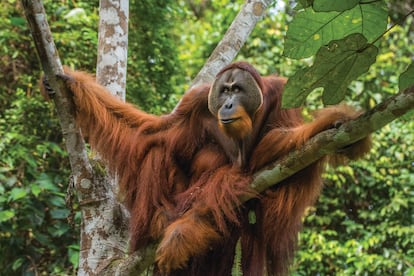
Much further south, in Kumai Bay, in the Indonesian part of Borneo, also known as Kalimantan, several klotoks (traditional river boats) carry tourists up the brown waters of the Sekonyer River, on their way to Tanjung Puting National Park. There, in 1971, Canadian primatologist Birutė Galdikas began her orangutan conservation work. She started by following orangutans in the wild for months, trying to understand the behavior of these animals. She also carried out the first rehabilitation program for captive orangutans kept as pets by the indigenous Dayaks. Of those primeval forests that sheltered the last great arboreal primates, today only scattered pieces remain. The nearly 1,158 square miles (3,000 square kilometers) of the park are home to about 6,000 specimens, most of them descendants of those survivors, and it has become a place of pilgrimage for nature lovers from all over the world.
“They have eight times the strength of a person. They build two nests a day. One for the night and one for the siesta, as we men do,” jokes Dodi, a local guide who manages to get a few laughs out of the couple of tourists he accompanies. Wearing a basketball cap and pants with pockets full of tiny bananas, he ties the klotok to the park’s jetty. Via wooden walkways, he enters the sanctuary. He walks ahead, emitting guttural sounds, hoping for a response in the form of an orangutan. Suddenly, a reddish spot moves nimbly among the low branches of a tree. A female, with her infant hugging her waist, reaches out her hand in the direction of the guide. She quickly grabs one of the bananas that he offers her. Esther, a young tourist from Barcelona, repeats the operation. But this time it is the baby that comes closer to get the coveted fruit. “It was incredible! Thank you, Dodi!” she exclaims, stifling a cry of joy.
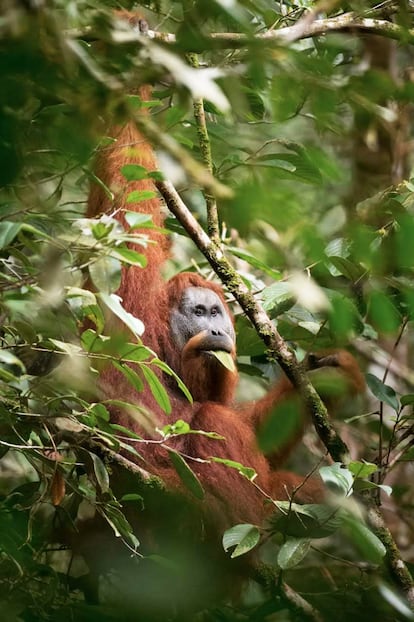
Successful coexistence or extinction
North of Tanjung Puting, the U.K. Orangutan Foundation has another research center, at Pondok Ambung, and five reintroduction camps in nearby Lamandu. “That’s almost 64,000 hectares closed to tourists where we have already released more than 300 rescued individuals into the wild, and as many more are waiting to be rehabilitated soon,” says Leiman. The Orangutan Project, also present in Sumatra, works on the ground to protect the forests and their inhabitants, without ignoring local communities. “We help them to develop sustainable agriculture by growing vanilla or collecting honey, for example. But the pandemic put many men out of work and that increased poaching and pressure on the environment,” says Cocks. There is no salvation for the orangutans without understanding the needs and problems of the rural populations. The only solution to avoid extinction, say conservationists and NGOs, is to achieve coexistence between people and the “men of the forest.”

Tapanuli, the recently discovered most-threatened great ape
In 2017, scientists described a third species, the Tapanuli orangutan (Pongo tapanuliensis), which is more slender and not as hairy compared to, for example, the Bornean orangutan. It is located only in the mountainous areas of Batang-Toru, in an area of about 386 square miles (1,000 square kilometers) in the province of North Sumatra (Indonesia). Despite its recent discovery, it has the sad honor of being the most endangered great ape species on the planet. According to the IUCN, the Tapanuli orangutan — of which only about 800 are believed to exist — is critically endangered, just one step away from extinction. Scientists warn that while the species has taken thousands of years to come to light, its demise may be very rapid. The Indonesian government has approved the construction of a giant dam by PT North Sumatra Hydro Energy, right on the site of Tapanuli’s most densely populated orangutan population. “Some 42 individuals of the new species live there,” warns Wich, a member of the international team that helped describe it.

Sign up for our weekly newsletter to get more English-language news coverage from EL PAÍS USA Edition
Tu suscripción se está usando en otro dispositivo
¿Quieres añadir otro usuario a tu suscripción?
Si continúas leyendo en este dispositivo, no se podrá leer en el otro.
FlechaTu suscripción se está usando en otro dispositivo y solo puedes acceder a EL PAÍS desde un dispositivo a la vez.
Si quieres compartir tu cuenta, cambia tu suscripción a la modalidad Premium, así podrás añadir otro usuario. Cada uno accederá con su propia cuenta de email, lo que os permitirá personalizar vuestra experiencia en EL PAÍS.
¿Tienes una suscripción de empresa? Accede aquí para contratar más cuentas.
En el caso de no saber quién está usando tu cuenta, te recomendamos cambiar tu contraseña aquí.
Si decides continuar compartiendo tu cuenta, este mensaje se mostrará en tu dispositivo y en el de la otra persona que está usando tu cuenta de forma indefinida, afectando a tu experiencia de lectura. Puedes consultar aquí los términos y condiciones de la suscripción digital.
More information
Archived In
Últimas noticias
Most viewed
- Alain Aspect, Nobel laureate in physics: ‘Einstein was so smart that he would have had to recognize quantum entanglement’
- Mexico’s missing people crisis casts a shadow over World Cup venue
- Why oil has been at the center of Venezuela-US conflicts for decades
- Trump clarifies who is ultimately in charge in Venezuela: ‘Me’
- Mexico seeks to shore up its defenses following US incursion in Venezuela

